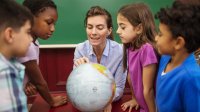How to Support Young Learners in Racially Diverse Classrooms
Teachers may be hesitant to discuss race with young kids, but these research-backed, age-appropriate strategies can help.
Your content has been saved!
Go to My Saved Content.Conversations about multicultural education, antiracism, and antibias are becoming more prevalent within educational communities. However, there may be hesitation and confusion about whether and how to create a classroom community that is supportive of children from racially diverse backgrounds—particularly ones who are younger.
In early childhood, educators may approach racial diversity and race-related issues from a color-blind philosophy or believe that young children are unable to understand issues of race due to their age. These approaches not only are dismissive of children and families’ experiences but also create an inaccurate portrayal of history and current events. Additionally, color-blind approach is an ableist term that equates actual medical blindness with ignorance and implies that racism is only connected to sight and negates the structural and day-to-day issues associated with racism.
As a result, educators should intentionally create a learning environment that respects and values racial diversity while addressing students’ experiences and the historical issues that shape those experiences. Here are five research-based approaches that early childhood educators can use.
Reflect on Who You Are and Your Experiences With Race
In order to create a learning environment that authentically supports racial diversity, educators can start with self-reflection. Understanding oneself will reveal educators’ feelings, thoughts, and attitudes about race and how they influence interactions and expectations with students.
Even if teachers share a similar racial background with students or self-identify as a BIPOC, it does not mean that they’re aware of how race and culture influence their teaching. Educators can try journaling or having peer discussions to reflect on how their teaching practices are influenced by race and culture.
Remember Intersectionality
In addition to race, many children and families may experience other forms of discrimination and oppression when they belong to multiple identity groups simultaneously, such as gender, class, ability, language, or sexual orientation. Children may be blamed for problems or experience erasure because of their multiple identities. Therefore, creating learning environments that are supportive of racial diversity should also be inclusive of children’s multiple identities. You can use resources like Photovoice, films, and texts to encourage students to reflect on the experiences of children and families with intersectional identities and think of ways they can be supported.
Discover Something to Love About Each Student
Even though children come from different racial and ethnic communities, it’s important to balance that with recognizing students individually. To build learning environments that affirm and acknowledge racial diversity and intersectional identities, educators should discover something to love about each child in the classroom. This love and connection can develop through visiting the children’s homes, meeting with families and community members, or interacting during recess or outdoor activities.
Avoid Tokenism
Educators should avoid doing one-off projects that reinforce stereotypes about different groups of people. Educators may incorporate activities and lessons that expose students to historical knowledge about people from a variety of racial and ethnic groups, the oppression experienced by people of different racial and ethnic groups, and the ways in which different groups have historically and currently contributed to national culture and society. When doing this, it’s valuable to not position one or two well-known individuals as representative of their entire cultural community.
Educators may also share depictions of people building friendships with those from different backgrounds. These lessons can help reduce children’s prejudice and negative attitudes toward people from different racial groups and increase young students’ feelings about racial fairness. Even if students in the setting are more racially homogeneous, children can still benefit from being exposed to and learning about other races in nonstereotypic portrayals.
Build Bridges
Educators can implement activities that specifically address race-related topics or conversations. Students can read books that feature characters of different skin tones, then have a conversation about the importance of making friends with people from different backgrounds.
They can also make self-portraits by mixing paint colors or using crayons that match the children’s skin tones. In this activity, children can see variation within their own and possibly other racial groups. This also may be a chance for students to observe colors associated with racial groups, like white, and notice if there are students who match that skin tone that may identify as White. For classes that are conducted virtually, students can use online painting tools.
Students may also compose books and photo journals or engage in oral storytelling to share information about themselves and their families with their peers. If educators notice children separating into racial groups in the classroom, they may have students complete activities and projects with different buddies, particularly those they may not choose to play with.
When educators start with understanding themselves and then expand that to understanding the experiences of others, they can intentionally cultivate a learning environment that honors racial and intersectional diversity within the classroom and the larger society. It is not a practice that has an end result; rather, it’s a process that requires consistent reflection, learning, and growth.
